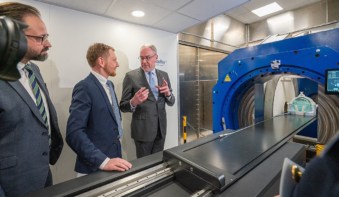Physicists in Canada have used a conventional magnetic resonance imaging (MRI) system to control the movement of a small metal bead inside blood vessels. The experiment demonstrates that MRI systems could eventually control tiny "untethered" devices that perform truly non-invasive surgery (App. Phys. Lett. 90 114105).
In the 1966 movie Fantastic Voyage, scientists climb into a submarine, shrink themselves down to the size of a red blood cell and are then injected into a dying man to break a blood clot. 40 years on, and the art of shrinking is still far away in the realms of science fiction – but the remote control of miniature devices to perform surgery in the bloodstream may not be.
In a proof-of-concept experiment, a team led by Sylvain Martel from the Nano Robotics laboratory in the École Polytechnique de Montréal has used a conventional MRI system to navigate a 1.5 mm ferromagnetic bead inserted into the blood vessels of a live pig. By individually controlling the magnetic field produced by the MRI system’s three perpendicular magnets, they could propel the bead in 3D around the blood vessels at speeds greater than 11 cm/s.
However, this ability would have been useless if Martel’s team was unable to see where the bead was going, so they devised an algorithm that rapidly alternated the MRI system’s magnets between “propulsion” and “tracking” modes roughly every 20 ms. While in tracking mode, the MRI system behaved as it would when performing a typical diagnostic scan of a patient – in other words, measuring how both the bead and the surrounding tissue interact differently with the magnetic field. The resultant image was then fed into a computer, which calculated the field required to navigate the bead within an accuracy of almost half a millimetre.
After many tests, the physicists found that navigation in arteries roughly twice the bead’s diameter was relatively easy. However, Martel told Physics Web that narrower vessels would need the bead to become smaller than a red blood cell, and extra magnets would be required to create enough force to direct it.
Currently, the least invasive way to operate inside a patient is through “keyhole” surgery, whereby medical instruments are contained in a flexible rod inserted through a small incision. But Martel thinks that one day MRI systems could control various “untethered” devices that perform surgery without the need for incisions at all. For example, simple devices could be fed into the bloodstream to reopen blocked arteries or target aneurysms. “We are presently developing more complex and much smaller micro-devices for various applications, such as targeted drug delivery and navigable biosensors for diagnostics,” said Martel.



